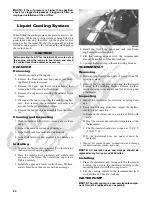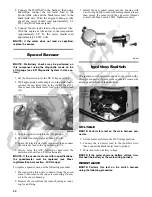
93
3. With the engine running at a constant 3000 RPM
(with the headlights on), the meter must show
14-15.5 DC volts.
NOTE: If voltage is lower than specified, test charg-
ing coil - no load.
VOLTAGE (Charging Coil - No Load)
The connector is the black three-pin one on the right side
of the engine just above the starter motor.
NOTE: Test the engine-side of the connector.
1. Set the meter selector to the AC Voltage position.
2. Test between the three black wires for a total of three
tests.
3. With the engine running at the specified RPM, all
wire tests must show 60 AC volts.
NOTE: If both charging coil tests failed, check all
connections, etc., and test again. If no voltage is
present, replace the stator assembly.
RESISTANCE (Charging Coil)
1. Set the meter selector to OHMS position.
2. Test between the three black wires for a total of three
tests.
3. The meter reading must be within specification.
RESISTANCE (Crankshaft Position
Sensor)
1. Disconnect the gray four-pin connector on the right
side of the engine just above the starter motor.
2. Set the meter selector to the OHMS position.
3. Connect the red tester lead to the green/white wire;
then connect the black tester lead to the blue/yellow
wire. The meter reading must be within specifica-
tion.
PEAK VOLTAGE
NOTE: All of the peak voltage tests should be made
using the Fluke Model 73 Multimeter or Fluke Model
77 Multimeter with Peak Voltage Reading Adapter. If
any other type of tester is used, readings may vary
due to internal circuitry.
NOTE: The battery must be at full charge for this
test.
Crankshaft Position Sensor
1. Set the meter selector to the AC Voltage position.
2. Connect the red tester lead to the green/white wire;
then connect the black tester lead to the blue/yellow
wire.
3. Crank the engine over using the electric starter.
4. The meter reading must be within specification.
Starter Relay
1. Remove the seat; then using the multimeter set to the
DC Voltage position, check the relay as follows.
2. Connect the red tester lead to the positive battery ter-
minal; then connect the black tester lead to the starter
cable connection on the starter relay. The meter must
show battery voltage.
NOTE: Make sure that the ignition switch is in the
ON position, transmission in neutral, brake lock
released, and the emergency stop switch in the RUN
position.
3. Depress the starter button while observing the multi-
meter. The multimeter should drop to 0 volts, a
“click” should be heard from the relay, and the starter
motor should run.
NOTE: If a “click” is heard and any voltage is indi-
cated by the multimeter, replace the starter relay. If no
“click” is heard and the multimeter continues to indi-
cate battery voltage, test the neutral start relay.
Starter Motor
NOTE: The starter motor is a non-serviceable com-
ponent. If the following test does not result as speci-
fied, the starter motor must be replaced.
TESTING VOLTAGE
Perform this test on the starter motor positive terminal.
To access the terminal, slide the boot away.
NOTE: The ignition switch must be in the ON posi-
tion, the emergency stop switch in the RUN position,
and the shift lever in the NEUTRAL position.
1. Set the meter selector to the DC Voltage position.
2. Connect the red tester lead to the starter terminal;
then connect the black tester lead to ground.
3. With the starter button depressed, the meter must
show approximately 10.0 DC volts and the starter
motor should operate.
CAUTION
Do not run the engine at high RPM for more than 10 sec-
onds.
CAUTION
Do not run the engine at high RPM for more than 10 sec-
onds.
















































